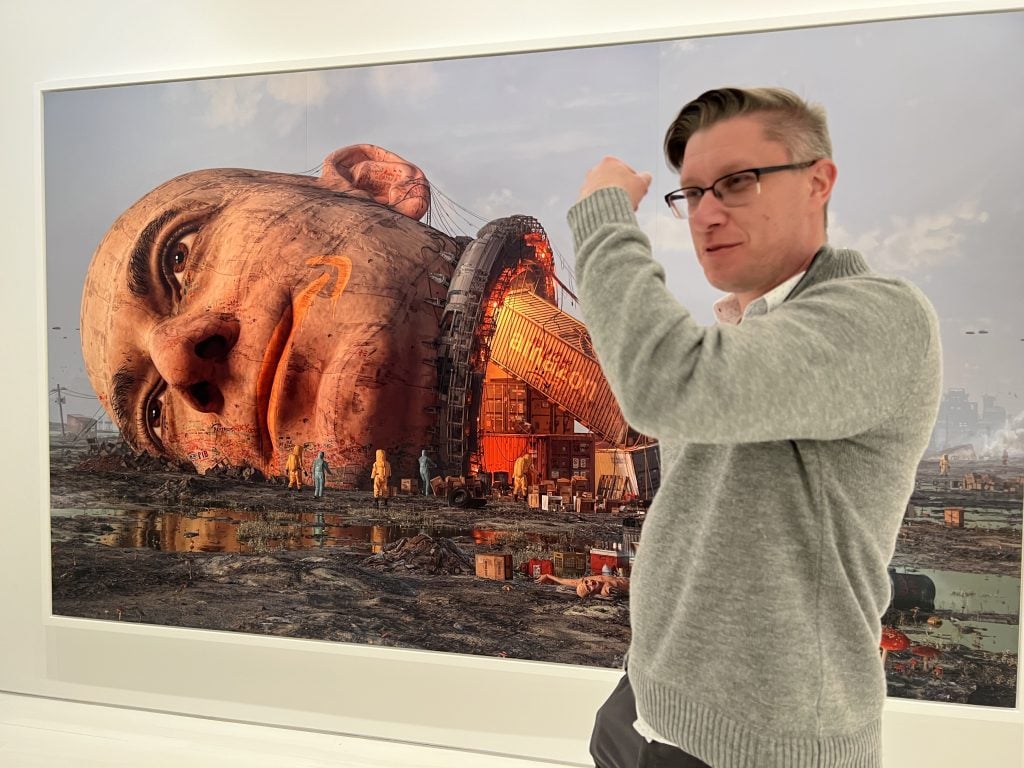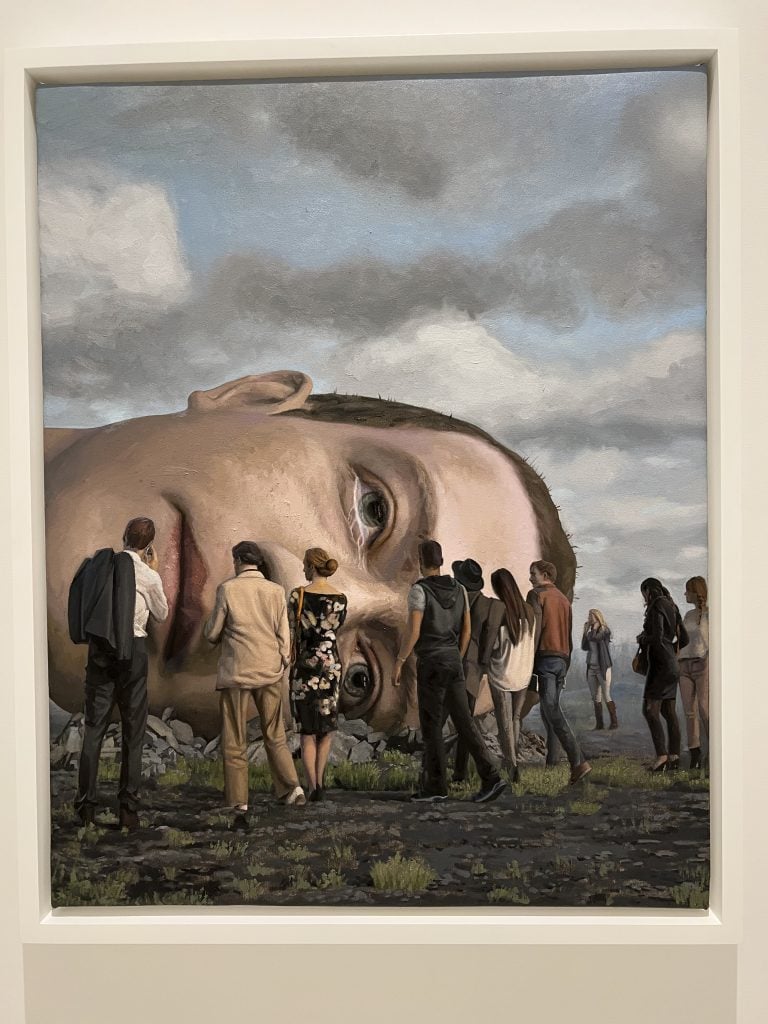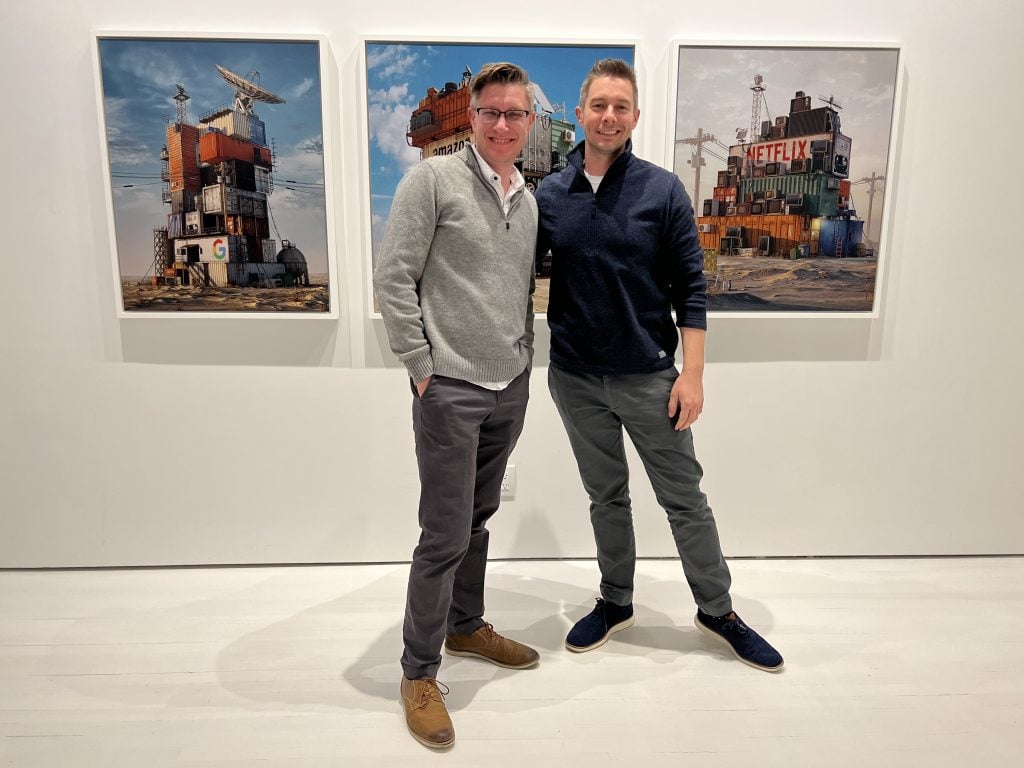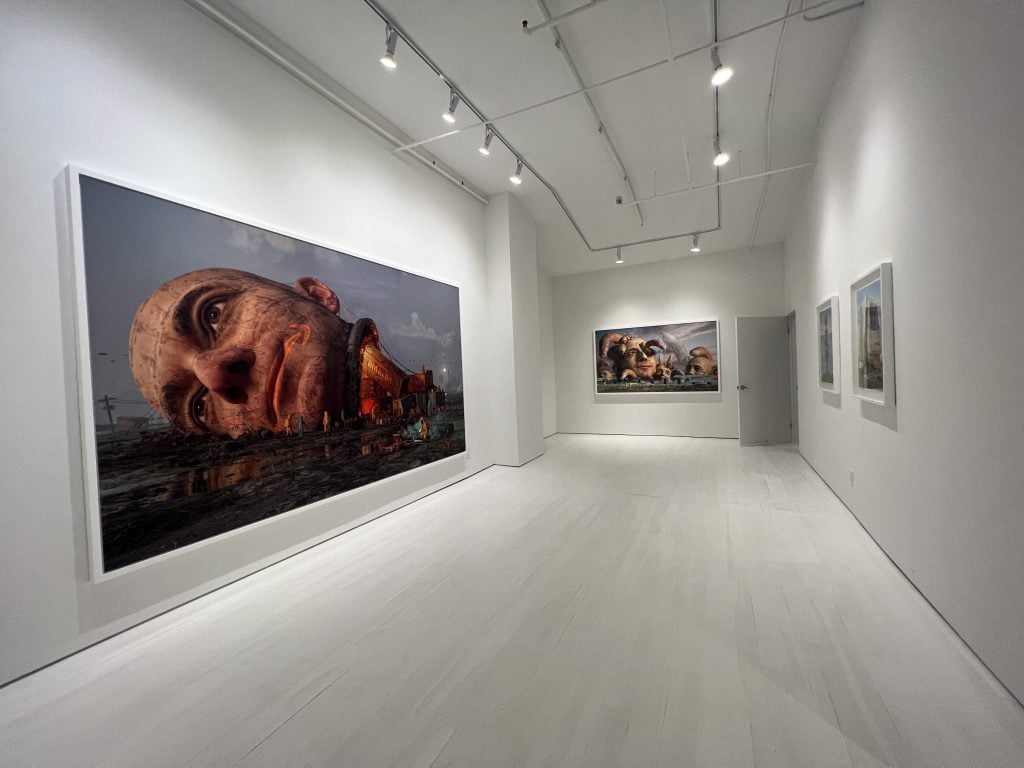People
‘I’ve Never Even Been to a Gallery Opening’: NFT Star Beeple on Trading Pixels for Paintings in His First-Ever Gallery Show
Mike Winklemann is making inroads to the traditional art world with a solo show at Jack Hanley.

Mike Winklemann is making inroads to the traditional art world with a solo show at Jack Hanley.

Katya Kazakina

On the eve of his New York solo debut, artist Mike Winkelmann, better known as the breakout NFT star Beeple, was making the final rounds at Jack Hanley gallery in Tribeca.
Things were looking good: His show, “Beeple: Uncertain Future,” was all installed, filling the gallery with violent, apocalyptic imagery of piled-up Amazon shipping containers, zombie-like factory workers, and huge, severed heads of Jeff Bezos and Mark Zuckerberg. All of the 13 prints and paintings had been reserved, with prices ranging from about $75,000 to $300,000.
The show opens almost exactly a year after Beeple’s NFT, Everydays: The First 5,000 Days, fetched $69.3 million at Christie’s, catapulting the artist to overnight stardom and unleashing the NFT tsunami. During this year, Winkelmann has become, put plainly, rich and famous.
Winkelmann’s exhibition, which opens today, is a hotly anticipated if somewhat polarizing event. More than 1,100 people RSVP’d for the opening reception in just 24 hours—leading the normally low-key gallery to hire security guards and stanchion posts.

Zuck (2021-22) by Beeple. Photo: Katya Kazakina.
The art world has been more critical. Artnet News art critic Ben Davis wasn’t impressed after reviewing all 5,000 images in The First 5,000 Days. Some artists represented by Hanley quit in protest, demanding that their names be scraped from the gallery’s website before the opening. (“They didn’t even see the show!” said Hanley. “These aren’t even NFTs!”)
Winkelmann, 40, is navigating this new landscape with confidence and savvy, while staying grounded in the digital art community he’s been part of for two decades. He has continued to create a daily art project as part of his ongoing “Everydays” series, and to post each one on social media for his 2.5 million Instagram followers and nearly 600,000 followers on Twitter (in the past week, the works centered on Russia’s invasion of Ukraine). Much of the proceeds from his art sales have gone back into his studio and he plans to donate a portion of his proceeds from the Jack Hanley exhibition to charities counteracting the ills of Big Tech, including conservation, privacy, and teen suicide.
His newfound wealth gave Winkelmann freedom to dream big. His current studio, the third he’s set up in a year, is a 50,000-square-foot building in an industrial park in Charleston, South Carolina. His younger brother Scott Winkelmann quit his job at Boeing two years ago, where he was a manager of the design engineering team, to run the Beeple operation. The team now consists of 16 full-time employees, including several aerospace engineers from Boeing.
“These guys left because they wanted to do something different,” Scott Winkelmann said. There are also digital artists, software engineers, mechanical engineers, and electrical engineers.

Mike Wikelmann is building out his new 50,000 square foot studio to look like a museum or high-end gallery. Courtesy: Mike Winkelmann
They’ve been working on pieces that mix physical and digital art, similar to Human One, a kinetic video sculpture made of four vertical screens showing a man in a silver spacesuit marching through a desolate landscape. (Today, Winkelmann updated the man’s uniform to appear in the colors of Ukraine’s flag, and he now walks through a war zone.) The work’s owner, crypto investor Ryan Zurrer, said he is in talks with museums to display the sculpture.
“My constant focus is not on what is interesting art now, but on what art will look like in 100 years,” Mike Winkelmann said in a recent interview with Artnet News. “I feel super, super lucky having a team around me that I can be like, ‘Hmm guys, what if we do this?’ And, and they’re like, ‘Okay, we’ll figure it out.’”
The specific projects are top secret, but the general direction is ambitious. Half of the studio space, about 25,000 square feet, will be divided into two exhibition areas, each with 20-foot-tall ceilings. “We’ll be able to make the work right there and show it immediately,” Winkelmann said.
One of the exhibition spaces will be dedicated to a survey of Winkelmann’s artworks over the past 20 years, as well as the history of the community of digital art and design that he came up through.
The second space will be experiential, with high-end cameras and projectors.
“Like an immersive Van Gogh exhibition,” Winkelmann said. “It will be a place where I can do whatever I want. It will look very similar to a higher end gallery or museum when we are done. Being able to test out ideas there to me is super exciting and something that I could have only ever dreamed of.”

Brothers Mike Winkelmann (left) and Scott Winkelmann at “Beeple: Uncertain Future” at Jack Hanley, New York. Photo: Katya Kazakina.
His family is on board to make this happen. In January, when Winkelmann had Covid-19, his mother broke the ground on the construction site. His father recently set up a healthcare plan for the employees. His wife is handling finances and infrastructure. And his brother Scott manages the day-to-day operations. They all came to New York to see Winkelmann’s Human One sell for $29 million at Christie’s in November.
“So it’s very much a kind of a family operation at this point,” Winkelmann said. “Which is ironic because they never used to be interested in art. Like there was no mention of art ever. And now my mother knows more about NFTs than you do.”
You won’t see any NFT art or a screen at Jack Hanley gallery (although each artwork is registered on the blockchain). Instead, the works are painted and printed on traditional surfaces: oil on canvas, pastel on paper. There are large-scale prints, almost 7 feet tall and 11 feet wide.
“The theme of this show is our relationship with technology,” Winkelmann said. “Again, with some humor and satire, but looking at the outsize influence that very few companies, you know, Google, Facebook, and Amazon, have on our everyday lives. Zuckerberg could wake up in the morning and say ‘Hey, let’s do X, Y, Z,’ and that’s going to affect the entire world almost immediately. And so I think we need to take a step back and think about some of these things.”
The focus on traditional art media is intentional “to help people get past all the other things and look at the images themselves,” Winkelmann said. “Does it really matter if I paint these things or if they were made on a computer? I’m much more interested in what you are trying to express with this versus what tools you used to get to that place.”
You may be wondering if Winkelmann picked up a paint brush to actually paint his works. The answer is no, they were done by the studio. “I can tell you I’m not a painter,” he said.
In fact he’s so new to the traditional art world that “I’ve never even been to a gallery opening,” he said, “much less had my opening.”

Installation view of Beeple’s show at Jack Hanley, New York. Photo: Katya Kazakina.
He spends a lot of time dreaming things up. In his office he’s upgraded from two to six television screens, each set to a different news channel, on mute.
“It’s like a window of information of what’s going on in the world, which has been pretty fucking depressing,” he said. In the past week, as the news of Russia’s war in Ukraine dominated the news cycle, his “Everydays” have focused on the conflict: starting with a tattered yellow and blue Ukrainian flag amidst the ruins, titled Stand with Ukraine. As the fighting intensified and human toll soared, he posted Drowning, depicting the head of Vladimir Putin, submerged in a sea of blood.
“At times like this, I feel like how can you not comment?” Winkelmann said. “I feel fortunate having that as kind of an outlet, especially because it has nothing to do with money or sales or collectors or any shit like that. This is just a way for me to express what I’m feeling, which is the whole point of art.”